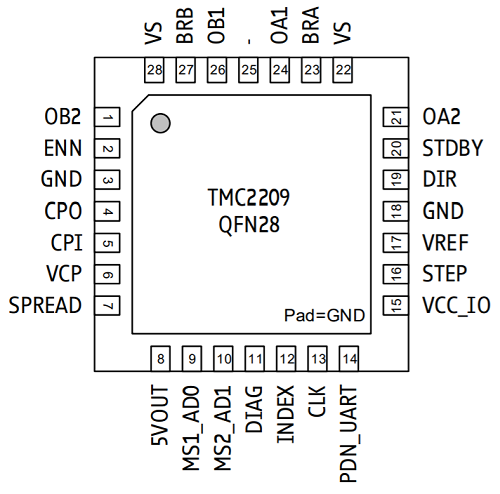So, in this guide, we will take closer look at the TMC2209 IC, understand some of its features and specifications, pin diagram and description and many more. If you are a beginner trying to work with TMC2209 (or other similar Stepper Motor Drivers), then this guide will definitely help you getting familiar with the IC.
What is TMC2209?
Trinamic Motion Control is a German company that develops motor driver ICs, encoders and other motor drive related products. Trinamic’s TMC2209 is 2-phase Stepper Motor Driver IC. It has several proprietary features integrated into the silicon that ensures maximum efficiency, noiseless operation and provides the best torque values. When it comes to the drive currents, the TMC2209 can handle motor currents up to 2A (RMS) or 2.8A (peak) per coil. You can interface TMC2209 with a microcontroller through UART and provide the control and tuning commands. There is also an on-chip OTP memory to store the tuning values. Image It supports a wide range of stepper motor voltages (4.75V to 29V) and the operating voltage is 5V. Combine this with the fact that noiseless operation is its main feature, this low-cost IC is a serious contender to several battery-operated applications. The TMC2209 IC is available in a 28-pad QFN (Quad Flat with No-Leads) Package.
TMC2209 Specifications
Here is a quick list of some important features and specifications of TMC2209.
Two-Phase Stepper Motor Driver IC 28-Pad QFN Package Peak Coil Current is 2.8A and Coil RMS Current is 2A Motor Supply Voltage is 4.75V to 29V IC Operating Voltage is 5V 8, 16, 32 or 64 microsteps with STEP/DIR Interface Both Low-Side and High-Side RDSON values are 170mΩ On-chip Oscillator Frequency is 12MHz Maximum External Clock Frequency is 16MHz Microcontroller Communication Interface: UART Special Features: MicroPlyer, StealthChop2, SpreadCycle, StallGuard and CoolStep Suitable Applications: 3DPrinters, Desktop Printers, CCTV, HVAC, Home Automation, Battery Operated Devices
Special Features
There are some special and trademarked features integrated in the silicon of TMC2209 IC that help in achieving excellent efficiency, reliability, precision and smoother operation. Here is a brief description of these features.
MicroPlyer: It is a microstep interpolator that helps in a smooth microstepping in 256 steps. StealthChop2: A high-precision chopper algorithm for noise free operation. SpreadCycle: It is a high-precision cycle-by-cycle current control for fast current regulation and dynamic movements. StallGuard: A Sensor less warning mechanism for motor overloads. CoolStep: Using the StallGuard data, the CoolStep modifies the motor current to achieve best efficiency with less heat.
Operating Principle
The TMC2XX is an important family of Stepper Motor Driver ICs from Trinamic and the TMC2209 is low-cost, cost-effective solution for noiseless and precise stepper motor operation. In the following image, you can see the basic application block diagram of TMC2209 IC. Using just a few control pins, you can control the IC using a microcontroller over UART. One important setting is adjusting the step resolution, for which you have a choice of 8, 16, 32 or 64 steps. Its StealthChop2 technology, a proprietary silent drive system enables you to have a noiseless operation. With MicroPlyer technology, you can achieve further micro stepping up to 256 steps.
Modes of Operation
The TMC2209 Stepper Motor Driver IC has three modes of operations. They are:
Standalone STEP/DIR Driver Mode Standalone STEP/DIR Driver Mode with OTP Pre-configuration STEP/DIR Driver Mode with Full Diagnostics and Control
In the Standalone STEP/DIR Driver Mode, a microcontroller is responsible for commanding the TMC2209 IC with proper STEP and DIR signals. In the second mode, you can enable additional options using the OTP Memory (or store the configuration details in the microcontroller and load them during start-up). Coming to the diagnostics mode, you can unleash additional diagnostics, reduce the step resolution to 256, thermal management and other features.
Pin Diagram and Description
As we mentioned earlier, the TMC2209 Stepper Motor Driver IC is available in a 28-pad QFN package. The following image shows the pin diagram of the IC.
We will now see the function of each pin of the IC with the help of the following table.
Sample Circuits
Let us now see some sample circuits involving TMC2209 Stepper Motor Driver IC. We will see three circuits along with respective external components for those circuits.
Standard Application Circuit
In this circuit, we use a minimum set of external components. Two sense resistors RSA and RSB help us in setting the individual motor coil current. All the power supply filtering capacitors have low ESR. You can use the 5VOUT to supply the VCC_IO or use an external regulator.
Internal Sense Resistors
You can save space and cost by omitting external sense resistors and use internal current sensing. To set the reference current, you have to use an external resistor at the VREF pin.
Circuit for 5V Supply
You can use the following circuit to run the IC from a 5V supply and the motor supply is 4.7V to 5.4V. To minimize the voltage drop of the linear regulator, we have to use high capacitance filters. Also, we have to bridge the internal 5V regulator (5VOUT) with the external power supply using a bridge resistor.
Conclusion
The TMC2209 is a very popular Stepper Motor Driver IC. You can find modules in several DIY Projects and the IC integrated into 3D Printers, home automation systems and many more. This is a beginner’s guide to TMC2209 IC with explanation of its features, specifications, pins and their functions. We also saw some sample application circuits. Comment * Name * Email * Website
Δ






![]()